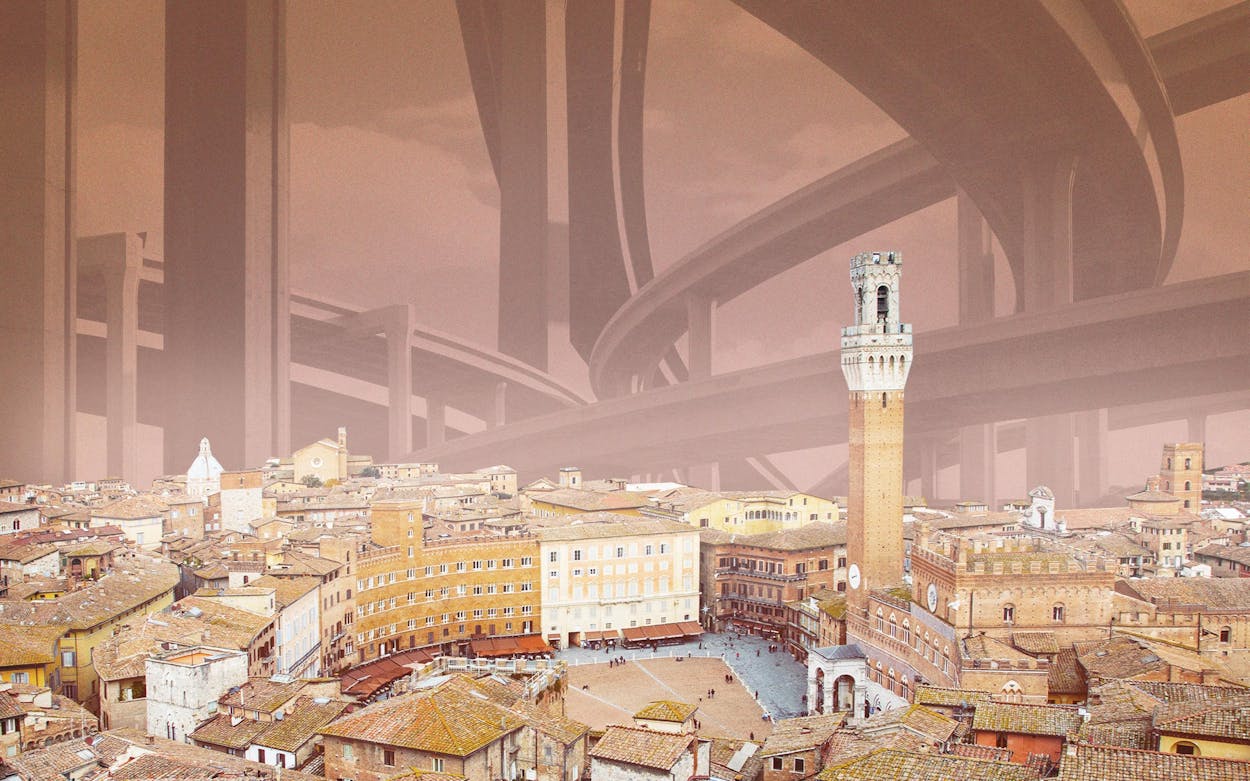Last week, a tweet went viral for pointing out in a novel way something that remains a source of fascination among Texans and non-Texans alike: Houston is really, really big, y’all.
https://twitter.com/michael_hendrix/status/1296183604851212288
In his Twitter post, Michael Hendrix of the Manhattan Institute, a free-market think tank, pointed out that the city center of Siena, Italy, packs roughly 30,000 residents into a space roughly the same size as one of Houston’s countless stack interchanges. Hendrix pulled this eye-opening comparison from a report compiled by the U.K.’s Building Better, Building Beautiful Commission, which sternly suggests that housing 30,000 Italians is less wasteful and more sustainable than using the same amount of acreage to simply move cars around. There’s truth to that, of course—designing cities around cars leads to high carbon emissions and road fatalities, and forces most folks to undertake interminable, congested commutes. But there’s more to the story. Understanding how Houston ended up with a seemingly endless array of five-stack interchanges, while the bulk of Siena’s population lives inside a UNESCO World Heritage Site, is complicated.
Siena’s history dates back millennia. Houston, meanwhile, was founded in 1836. Siena’s population has been stable for generations; the Houston area has ballooned in size by a factor of nearly twenty since 1940. Like many Sun Belt cities, Houston’s population boom coincided with the rise of the automobile. Highways followed cars followed people. Houston is also a genuinely massive place. Going from one end of Beltway 8 to the other is roughly the same distance as going from the middle of Staten Island past the Bronx and all the way up to Yonkers (a high-risk journey if every other gang in the city is looking to waste you because they think you shot Cyrus!). But it wasn’t strictly an “everything is bigger in Texas” ethos that caused Houston to sprawl the way that it does. Rather, Cold War–era urban design philosophy in the U.S. prioritized sprawl because older cities that had urbanized pre–World War II—New York, Chicago, Philadelphia, and Detroit—were seen as being susceptible to nuclear strikes. Less-dense cities such as Los Angeles and Houston were less likely to be targeted for a nuclear attack. Sprawl was a deterrent against Soviet aggression.
The highways themselves were specifically intended to facilitate the reasonable objective of Houstonians not to get annihilated by a nuclear blast. The Federal Aid Highway Act of 1956 was, according to the historian Elaine Tyler May in her book Homeward Bound: American Families in the Cold War Era, specifically intended to facilitate evacuations in the case of atomic attack. “The cold war made a profound contribution to suburban sprawl,” she writes, citing a 1951 issue of the Bulletin of Atomic Scientists about “defense through decentralization,” a concept so influential among American politicians that when Eisenhower signed the bill into law, he explained the reason for developing the highway system as a defense initiative. “[In] case of atomic attack on our key cities, the road net must permit quick evacuation of target areas,” she quotes the president as saying.
The threat of a Russian nuclear strike has diminished with the collapse of the Soviet Union (it’s been a weird year, though, so completely ruling out anything feels like tempting fate), and Houston has continued sprawling even as the existential risks to American cities have changed. Houston wasn’t alone in being built around intentional sprawl as a nuclear defense measure—the design principle was fairly widely implemented across the U.S., and is clearly evident in cities across Texas, where Houston is joined by fellow sprawlers like San Antonio and the Dallas–Fort Worth Metroplex. It’s hard to argue with the charms of a compact, historic, beautiful city like Siena, but there was a time not that long ago in world history when housing zero people within a footprint the size of a European city was considered a national defense priority. The world has evolved—climate change, spurred in part by all of that suburban sprawl, is probably a bigger threat to Houston at this point than global thermonuclear war—but it’s worth remembering that, at the very least, Houston didn’t end up like that by accident. Think about that the next time you’re doing 80 mph on one of Houstons fourteen expressways.
- More About:
- Politics & Policy








